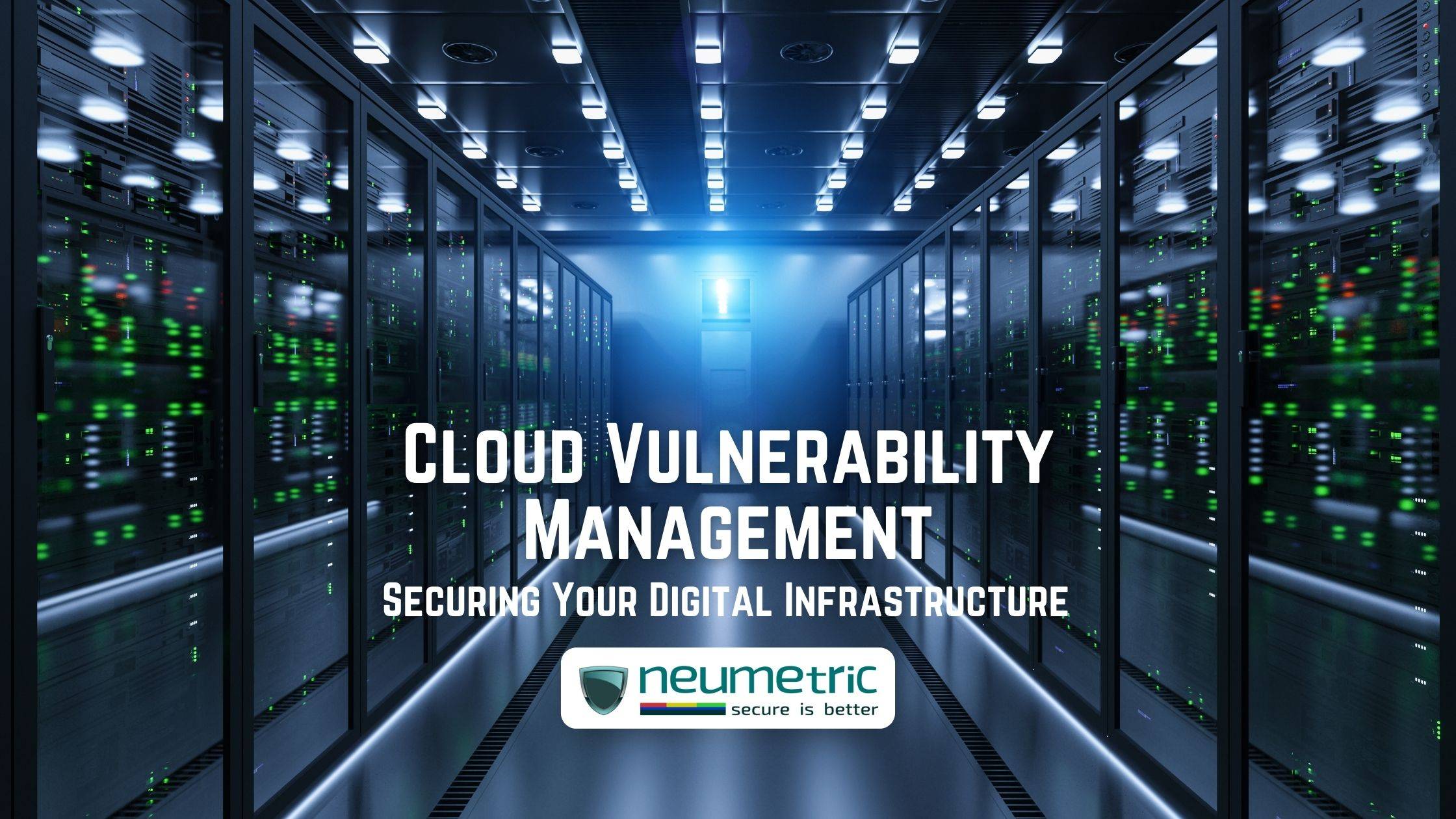Table of Contents
ToggleCloud Vulnerability Management: Securing Your Digital Infrastructure
Introduction
Cloud vulnerability management is crucial in today’s digital landscape as organisations increasingly rely on cloud services. Effective management helps identify & mitigate vulnerabilities, preventing unauthorised access, data breaches & service disruptions. It ensures the integrity, confidentiality & availability of cloud resources, safeguarding sensitive information & maintaining customer trust. Continuous monitoring, patch management, vulnerability scanning & proactive risk assessment are essential components of a robust cloud vulnerability management strategy.
Cloud vulnerabilities are weaknesses in cloud systems exploited by malicious actors. They stem from misconfigurations, outdated software, inadequate access controls or insecure APIs. Exploiting them can cause unauthorised data access, loss, service disruptions, compliance violations, financial losses, reputational damage, legal consequences & compromised trust.
To secure cloud environments, organisations need strong access controls, monitoring, encryption, network segmentation, patching & employee training. Adhering to these practices is essential for maintaining a secure cloud & mitigating risks associated with vulnerabilities.
Understanding Cloud Vulnerabilities
Overview of common vulnerabilities specific to cloud infrastructure includes:
- Inadequate authentication & access controls: Weak or misconfigured access controls can lead to unauthorised access to sensitive data & resources.
- Insecure interfaces & APIs: Vulnerabilities in cloud interfaces & APIs can be exploited by attackers to gain unauthorised access or manipulate data.
- Data breaches & leaks: Cloud misconfigurations or weak security measures can result in data breaches or accidental exposure of sensitive information.
- Denial-of-Service [DoS] attacks: Cloud services can be overwhelmed by DoS attacks, causing service disruptions for both the cloud provider & its customers.
Some examples of real-world incidents caused by cloud vulnerabilities include:
- Capital One data breach (2019): A misconfigured firewall in the cloud allowed an attacker to gain unauthorised access to Capital One’s customer data, affecting over 100 million individuals.
- Tesla’s AWS account hijacking (2020): An unsecured Kubernetes Console in Tesla’s cloud infrastructure was compromised, leading to unauthorised cryptocurrency mining.
- GitHub’s account takeover (2020): Weak authentication mechanisms allowed attackers to compromise GitHub accounts, leading to unauthorised access & data theft.
The need for proactive cloud vulnerability management primarily includes:
- Rapid growth of cloud adoption: As organisations increasingly rely on cloud services, it becomes crucial to prioritise proactive vulnerability management to safeguard critical data & assets.
- Dynamic cloud environments: Cloud infrastructures are highly dynamic, making it essential to continuously monitor & address vulnerabilities to prevent exploitation.
- Shared responsibility model: Cloud security is a shared responsibility between the cloud provider & the customer, emphasising the need for proactive vulnerability management on both ends.
- Compliance requirements: Organisations must comply with various data protection regulations & proactively managing vulnerabilities helps meet these requirements & avoid costly penalties.
- Evolving threat landscape: Cyber threats constantly evolve & proactive vulnerability management ensures organisations can stay ahead of potential attacks & protect their cloud infrastructure from emerging threats.
Key Components of Cloud Vulnerability Management
Key Components of Cloud Vulnerability Management includes:
- Cloud asset inventory & visibility: It provides a comprehensive view of resources, aiding in accurate identification, reducing risks, optimising utilisation & ensuring compliance.
- Continuous vulnerability scanning & assessment: It identifies flaws in real-time, enabling prompt remediation, proactive security measures & ongoing asset protection.
- Configuration management & hardening practices: It establishes secure configurations, control changes, minimise attack surfaces, enforce policies & regularly update to protect against unauthorised access & vulnerabilities.
Cloud Security Best Practices
- Implementing strong access controls & authentication mechanisms: Implement strong access controls & authentication mechanisms, including Multi-Factor Authentication [MFA] & Role-Based Access Control [RBAC], to ensure authorised access.
- Encrypting data in transit & at rest within the cloud environment: Encrypt data in transit & at rest to secure communication & prevent unauthorised access. Encryption keys ensure data remains unreadable even if compromised, providing an extra layer of protection.
- Monitoring & logging for detecting & responding to threats: Monitor & log activities in the cloud environment for threat detection. Real-time alerts & log analysis enable timely response & mitigation. Regular review helps identify vulnerabilities & enhance security measures.
Cloud Provider Security Tools & Services
Major cloud providers offer security tools for data protection. AWS offers IAM, CloudTrail, GuardDuty, WAF, Shield, Macie. Azure provides AAD, Security Center, Firewall, DDoS Protection, Information Protection, Key Vault. GCP offers IAM, Security Command Center, Firewall, DDoS Protection, KMS, DLP. IBM Cloud provides IAM, Security Advisor, Firewall, DDoS Protection, Key Protect, Security Guardium.
Built-in security services play a crucial role in safeguarding our digital lives & protecting our data from potential threats. These services, integrated into various software applications & devices, offer several benefits & conveniences, but they also come with certain limitations.
Benefits:
- User-Friendly Implementation: Built-in security services are designed to be user-friendly with simple interfaces & intuitive controls, enabling individuals to protect their devices & data without extensive technical expertise.
- Seamless Integration: Built-in security services seamlessly integrate into existing systems, embedded within software applications or devices, eliminating the need for additional installations & reducing compatibility issues.
- Immediate Protection: Built-in security services offer immediate protection through real-time threat detection & mitigation features like antivirus scans, firewalls & intrusion detection systems, eliminating the reliance on external solutions.
Limitations:
- Limited Functionality: Built-in security services lack advanced features, threat intelligence & detection capabilities, leaving users vulnerable to sophisticated attacks.
- Dependence on Software Updates: Built-in security services require regular updates to stay effective against emerging threats; inadequate updates expose users to new vulnerabilities & attack vectors.
- Single Point of Failure: Built-in security services being part of a larger system means a single vulnerability or breach can compromise the entire security infrastructure, necessitating additional protection measures against targeted attacks.
To evaluate third-party security solutions for enhanced cloud vulnerability management:
- Understand the cloud environment by assessing multi-tenancy, data storage & network infrastructure.
- Look for comprehensive threat coverage, addressing data storage, network communication, access controls, identity management & compliance.
- Seek real-time monitoring & alerts with prompt vulnerability detection, threat intelligence, log analysis & automated incident response.
- Ensure compliance & regulatory support aligns with industry standards. Assess compatibility, integration capabilities & support for APIs, connectors & common security frameworks for seamless integration with existing tools.
Vulnerability Patching & Remediation in the Cloud
Timely patching & vulnerability remediation provide numerous advantages. They thwart exploits, bolster security & avert unauthorised access or data theft. Furthermore, they preempt data breaches by prioritising updates, fortifying systems & safeguarding sensitive information. These actions also curtail business risks, minimising financial losses, reputational harm & legal liabilities linked to cyber threats. Moreover, they guarantee compliance with industry regulations, sidestepping severe penalties & legal repercussions, all while fostering a secure & compliant environment.
Effective patch management in a cloud environment requires a Patch Management Framework with defined processes & dedicated teams. Risk Assessment & prioritisation help determine patching priorities by assessing impact & severity. Thorough Patch Testing in a separate environment ensures compatibility. Continuous Monitoring with robust tools promptly detects vulnerabilities, monitors patch compliance & identifies anomalies. These strategies enhance cloud security by enabling efficient patch management.
Automating patch management is crucial for efficient vulnerability remediation. By implementing automation tools & processes, organisations can streamline & expedite the patching process, reducing manual effort & minimising the risk of human error.
- Patch Deployment Automation: Automating patch deployment across multiple systems, saving time & scheduling installations during off-peak hours to minimise disruptions.
- Vulnerability Assessment Integration: To Integrate automated vulnerability assessment tools with patch management systems to identify & prioritise vulnerabilities, linking them to available patches for efficient remediation.
- Reporting & Analytics: To Automate comprehensive reporting & analytics on patching activities, including deployment status, compliance rates & vulnerability trends, for informed decision-making & enhancing security posture.
Continuous Monitoring & Incident Response in the Cloud
Continuous Monitoring & Incident Response in the Cloud includes:
- Implementing continuous monitoring for identifying new vulnerabilities: Regularly scan systems to detect vulnerabilities, assess risks & apply timely patches. This proactive approach maintains a robust security posture by staying ahead of emerging threats.
- Developing an effective incident response plan for cloud-related incidents: Include predefined roles, clear communication, incident classification & response procedures. Address cloud-specific challenges to ensure a coordinated & efficient response to cloud-related incidents, minimising impact & restoring operations quickly.
- Leveraging cloud-native security solutions for real-time threat detection & response: Utilise real-time threat detection & response with cloud-native security solutions. Leverage machine learning, AI & automation to monitor network traffic, analyse behaviour patterns & promptly identify & mitigate potential security breaches, enhancing overall security posture.
Compliance & Regulatory Considerations
Compliance requirements shape cloud vulnerability management for regulated industries. Navigating GDPR, HIPAA & PCI DSS is crucial due to specific data protection & security requirements. Compliance mandates include vulnerability assessments, prompt patching & security documentation. Understanding ensures alignment, robust security & data protection.
Industries possess distinct regulations & standards for cloud security. The financial sector adheres to regulations such as SOX, while healthcare organisations must comply with HIPAA. These industry-specific regulations define security controls & guidelines to protect sensitive cloud data. Awareness of these requirements is vital, as non-compliance can lead to legal consequences & reputational harm.
Data privacy regulations such as GDPR, CCPA & LGPD impact cloud security. They govern personal data collection, storage, processing & transfer, imposing strict protection requirements. Cloud vulnerability management must align, including data encryption, access controls & incident response. Compliance builds trust, avoids legal consequences & demonstrates commitment to data safeguarding.
Emerging Trends in Cloud Vulnerability Management
The rapid adoption of cloud computing has led to an evolving threat landscape. Cybercriminals target cloud environments, exploiting misconfigurations, insecure APIs & weak access controls. Securing multi-cloud & hybrid environments poses new challenges. Organisations must stay vigilant, implement robust security measures & stay updated on emerging cloud threats.
The future of cloud security brings challenges like managing security in complex multi-cloud environments, addressing cloud data privacy concerns & securing IoT devices. Advanced security measures, encryption & threat intelligence will play crucial roles. Automation & orchestration will streamline security operations, while AI & ML enable proactive threat detection, rapid incident response & adaptive security measures.
AI & ML revolutionise cloud vulnerability management by analysing data, detecting anomalies & automating vulnerability scanning. They prioritise vulnerabilities & predict future risks by analysing historical data. In complex cloud environments, AI & ML provide real-time threat intelligence, adaptive security measures & predictive analytics, empowering organisations to proactively manage cloud vulnerabilities.
Conclusion
The evolving landscape of cloud-based threats & vulnerabilities necessitates proactive measures in patch management, testing, compliance monitoring, vulnerability assessment integration & leveraging artificial intelligence & machine learning. The future of cloud security will bring both challenges & advancements, requiring organisations to address complex multi-cloud environments, privacy concerns & sophisticated cyberattacks.
Compliance requirements, industry-specific regulations & data privacy regulations have a significant impact on cloud vulnerability management. Understanding & aligning with these regulations are crucial for organisations to maintain a strong security posture, protect sensitive data & comply with legal obligations. Embracing advanced technologies & staying abreast of emerging threats will be essential in effectively managing vulnerabilities in the ever-evolving cloud environment.
FAQs:
What is cloud vulnerability management?
Cloud vulnerability management refers to the process of identifying, prioritising & addressing vulnerabilities within a cloud environment. It involves continuous monitoring, scanning & patching to ensure the security & integrity of cloud infrastructure & data.
What are the types of cloud vulnerability?
There are two main types of cloud vulnerabilities: infrastructure vulnerabilities & application vulnerabilities. Infrastructure vulnerabilities relate to weaknesses in the cloud infrastructure, such as misconfigurations or insecure network access. Application vulnerabilities, on the other hand, refer to security flaws within cloud-based applications or services.
What is cloud vulnerability assessment?
Cloud vulnerability assessment is the practice of evaluating & analysing the security posture of a cloud environment to identify potential vulnerabilities. It involves conducting systematic scans, penetration testing & risk assessments to determine the weaknesses that can be exploited by attackers.
What is CVE in cloud computing?
CVE stands for Common Vulnerabilities & Exposures. In the context of cloud computing, CVE refers to a publicly known identification number assigned to a specific vulnerability or exposure. CVEs are used to uniquely identify & track vulnerabilities, enabling organisations to stay informed & take appropriate actions to mitigate risks in their cloud systems.





